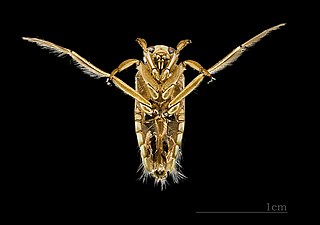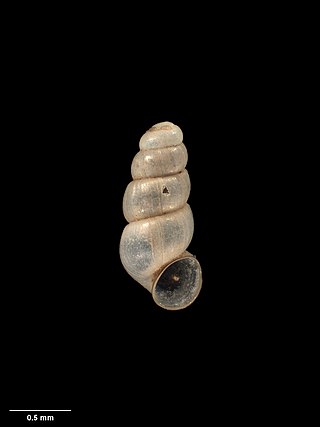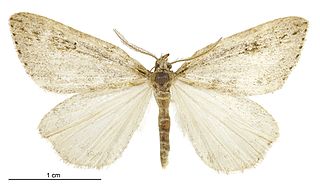
Corixidae is a family of aquatic insects in the order Hemiptera. They are found worldwide in virtually any freshwater habitat and a few species live in saline water. There are about 500 known species worldwide, in 55 genera, including the genus Sigara.

Nepidae is a family of exclusively aquatic Heteropteran insects in the order Hemiptera. They are commonly called water scorpions for their superficial resemblance to scorpions, due to their raptorial forelegs and the presence of a long slender process at the posterior end of the abdomen, resembling a tail. There are 14 genera in the family, in two subfamilies, Nepinae and Ranatrinae. Members of the genus Ranatra, the most widespread and species-rich genus, are sometimes called needle bugs or water stick insects as they are slenderer than Nepa.

Notonectidae is a cosmopolitan family of aquatic insects in the order Hemiptera, commonly called backswimmers because they swim "upside down" (inverted). They are all predators and typically range from 0.5 to 1.5 cm (0.2–0.6 in) in length. They are similar in appearance to Corixidae, but can be separated by differences in their dorsal-ventral coloration, front legs, and predatory behavior. Their dorsum is convex, lightly colored without cross striations. Their front tarsi are not scoop-shaped and their hind legs are fringed for swimming. There are about 350 species in two subfamilies: Notonectinae with seven genera, and Anisopinae with four genera. Members in the former subfamily are often larger than those in the latter.

Belostomatidae is a family of freshwater hemipteran insects known as giant water bugs or colloquially as toe-biters, Indian toe-biters, electric-light bugs, alligator ticks, or alligator fleas. They are the largest insects in the order Hemiptera. There are about 170 species found in freshwater habitats worldwide, with more than 110 in the Neotropics, more than 20 in Africa, almost as many in the Nearctic, and far fewer elsewhere. These predators are typically encountered in freshwater ponds, marshes and slow-flowing streams. Most species are at least 2 cm (0.8 in) long, although smaller species, down to 0.9 cm (0.35 in), also exist. The largest are members of the genus Lethocerus, which can exceed 12 cm (4.5 in) and nearly reach the length of some of the largest beetles in the world. Giant water bugs are a popular food in parts of Asia.

Nepomorpha is an infraorder of insects in the "true bug" order (Hemiptera). They belong to the "typical" bugs of the suborder Heteroptera. Due to their aquatic habits, these animals are known as true water bugs. They occur all over the world outside the polar regions, with about 2,000 species altogether. The Nepomorpha can be distinguished from related Heteroptera by their missing or vestigial ocelli. Also, as referred to by the obsolete name Cryptocerata, their antennae are reduced, with weak muscles, and usually carried tucked against the head.

The Ochteridae comprise a small family of insects. Eight genera with about 80 species have been described. They occur worldwide along the shore of various types of water and the greatest diversity is in tropical regions. They are "true bugs", being members of the order Hemiptera, and are in the suborder Heteroptera. Ochteridae commonly are known as the velvety shore bugs. They resemble the Saldidae shore bugs and have lengths ranging from 4.5 to 9 mm (0.18–0.35 in).
Sigara fallenoidea is a species of water boatman in the family Corixidae in the order Hemiptera. It was described by Hungerford and the type locality is in Canada. In Ireland Walton discovered a 'new' species of corixidae which he named Sigara pearcei. This was synonymised by Hungerford in 1950. The distribution of S. fallenoidea is therefore an extraordinary one including Canada, Ireland, Norway, Finland, Sweden, Ukraine and Russia. In Ireland, Sigara fallenoidea is found in all the large lakes on the island. There are confirmed records from Loughs Neagh, Beg and Portmore Lough; Upper and Lower Lough Erne; Lough Melvin; Loughs Ree, Derg and Key on the Shannon; and Lough Corrib.
Water boatman as a type of aquatic insect can mean:

Xanthocnemis zealandica, commonly known as common redcoat damselfly, red damselfly, or red coat damselfly, is one of the most common native New Zealand damselflies. Adult damselflies are often seen flying around vegetation close to streams.

Notonecta undulata, also known by the common name grousewinged backswimmer, are from the family Notonectidae and the insect suborder Heteroptera. They are a type of hemipteran or true bug. These aquatic insects typically spend their time at the water's surface, using their abdomen and legs to cling to the underside of the surface tension. The Grousewinged backswimmer can be found in both lotic and lentic environments; however, they typically prefer small ponds and lakes where the water is slow-moving with less current. They swim upside down looking for prey. Once they stop swimming they float back up to the surface. These insects can be distinguished from water boatman or Corixidae by their segmented beak and front legs. Water boatman have highly modified front legs whereas backswimmers do not. Backswimmers are distributed across a broad range throughout North America. However, the species Notonecta undulata has only been documented and studied in southern Manitoba, Saskatchewan, Alberta and the western United States. N. undulata differs from other backswimmers by their antennae and size. They are approximately 10–12 mm long, and their antennae are 4 segmented.

Archyala lindsayi is a species of moth in the family Tineidae. This species is endemic to New Zealand. It is classified as "At Risk, Naturally Uncommon" by the Department of Conservation.

Ericodesma cuneata, the Corokia leafroller moth, is a species of moth in the family Tortricidae. It is endemic to New Zealand. This moth is classified as "At Risk, Naturally Uncommon" by the Department of Conservation.

Elachista helonoma is a species of moth in the family Elachistidae. This species is endemic to New Zealand. It is classified as "At Risk, Relict'" by the Department of Conservation.

Kiwaia pumila is a moth in the family Gelechiidae. It is endemic to New Zealand. It is classified as Nationally Vulnerable by the Department of Conservation.
Kiwaia jeanae, also known as the Kaitorete jumper or mat daisy jumper, is a species of moth in the family Gelechiidae. It is endemic to New Zealand. This species is classified as "At Risk, Naturally Uncommon" by the Department of Conservation. Both the males and females of this species are brachypterous.

Catapyrgus sororius is a critically endangered species of fresh water snail endemic to New Zealand.

Pseudocoremia cineracia is a species of moth in the family Geometridae. It is endemic to New Zealand. It is classified as Nationally Vulnerable by the Department of Conservation.

Corixini is a tribe of water boatmen in the family Corixidae. There are about 9 genera and at least 30 described species in the genus Corixini.

Acroclita discariana is a species of moth in the family Tortricidae, endemic to New Zealand. It is classified as Nationally Vulnerable by the Department of Conservation.

Monteithiella humeralis, commonly known as the pittosporum shield bug is a species of herbivorous shield bug native to Australia and introduced in New Zealand. As its common name suggests, it is most commonly observed feeding on Pittosporum plants.

















